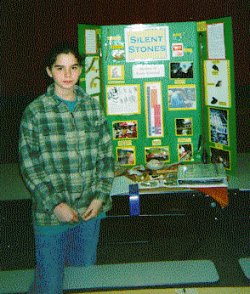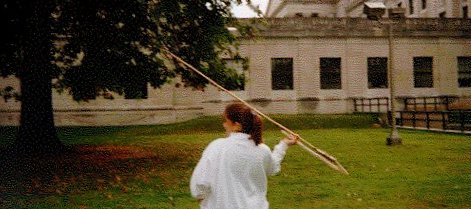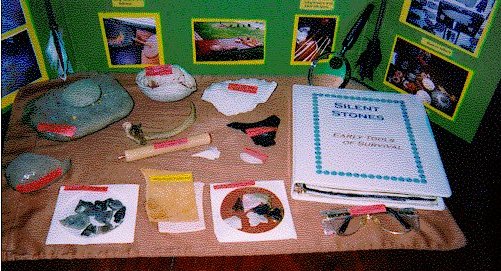
Jessica and her Project
SILENT STONES Secrets of Early Survival
by Jessica Dodson
About the Author: Jessica is a Sixth grade student from West Virginia. This report covers her Social Studies Fair project on stone tools. She placed first in her school and county competitions and will be taking her project to the State competition in mid May 1998. She'll add another hafted point and lots of new stone samples from all over the continent- thanks to Flint Forum. You can write to Jessica care of her mom, Shirley Dodson, at [email protected]. Best of Luck Jessica!
 |
|
Jessica and her Project |
Having an interest in early people and the past I wanted to know more about the tools that early people used. I decided to do some research and find out more about the stone age and its people.
I looked for information about who made stone tools, how long ago they began, what they made and methods they used for making them. I wanted to learn enough to try making some stone tools or points myself. I hoped this would give me an idea of what it was like trying to survive in an ancient world.
I visited the Grave Creek Museum in Wheeling, West Virginia. They have displays of stone artifacts there. I took some photographs so that I would remember what I saw . I also visited some archaeologists in Winchester who have made replicas of stone artifacts. I spoke with them and took pictures. Last fall I went to the Archaeology Fair in Charleston, West Virginia. There were displays, activities, and experts to talk to about all kinds of things in archaeology. I spoke to people, participated in activities, and took pictures. Some of the activities were making pottery, throwing spears with sticks attached called atlatls, trying out drills, toys, and other items, and going on a dig for artifacts. I met an archaeologist during our town�s Heritage Days who had a workshop on flintknapping or making stone tools. She gave me some stones and a stick with copper on it to use at home.
 |
|
Using Atlatl at the Archaeology Fair in Charleston |
I used my parents� computer to go online to find out more about stone tools and replicas. I found lists of good books and videos to look for and pictures and information to print. I found some places that sold stones and flintknapping tools. My mother helped me order some. I asked for some of the books that I had seen listed through inter-library loans. When they came in I studied them and viewed the movies to learn what I could.
One of my classmates at school has a large collection of stone projectile points and other artifacts at his home. I visited him and took pictures of the artifacts and talked with him about them. He loaned me some books and told me about a local Indian Museum with many Indian artifacts. I went there for a visit. The owner of this Indian Museum in Purgitsville, West Virginia, is Mr. Carl Champ. He showed me his collection of artifacts and answered my questions about what they were and how they were used. I also took photographs there.
I also collected some rocks at a riverbed near my home. I wanted to compare the types of rock in them to what I had seen in the local collections. I have a few projectile points and other stone artifacts that I had found near this river (the South Branch of the Potomac) and compared the rocks to them, also.
Through my research I found out that stones are not considered to be artifacts until man changes them in some way. If he breaks, scrapes or fastens things to them they are tools that would later be artifacts that can give information about the people who made them. If they are not used by man they remain silent stones forever.
The Stone Age began long ago in other parts of the world. People came to America by as Alaskan land bridge later and began settling here. The Paleo-Indian peoples made simple stone tools in our part of North America as long ago as 12,000 years ago. These early people were believed to have made and used spear points of various types for their main tools. These would help them hunt animals for food to eat.
The Archaic peoples, who existed from about 10,000 years ago to about 2500 years ago, made spear points and flint knives and axes or adzes. They also made mortars and pestles for grinding, pipes, awls for gouging holes, hammerstones for hitting other stones, pendants and birdstones for decoration, knife blades, scrapers for hides, drills and weights or bannerstones and plummets for atlatls on spears or nets. They could grind food and hunt even better.
The Early, Middle and Late Woodland Indians existed from about 2800 years ago to about 800 years ago (1200 AD.) The people slowly became more settled. Short trips could be made for hunting, then return for more tools at home. Points were probably re-sharpened as much as possible. Besides the items from earlier periods, they made more pottery for cooking and storing . They also made gorgets (decoration), celts (axes) and cones (for paint). The later Woodland people made more decorative ornaments and ceremonial pieces. Even later came the bow and arrow. This is why the artifacts people find are not often really arrowheads. They are probably spear or lance points.
The late Prehistoric people of about 1000 years ago made tools for fishing, and made decorated jars and bowls. They also made farming tools and stayed in one place longer.
The early people made many different types of tools. The tool found most often seemed to be projectile points. These could be for spears, lances, or arrows. It was these points that I tried to learn about making in a similar way to the Indians.
The early Indians would settle where there were good sources of plants, water, and rocks. Some kinds of rocks had to be heated in sand under slow heat to be useable. When they found rocks that were good for tools they would use harder rocks-as an anvil or to hit with or at-to break the stone to be worked into smaller pieces. Protection, such as from animal skin, was used on the hand or on the leg, if it was used. A tool called a billet would be used to pressure flake, or strip smaller flakes from the stones. Antlers were used or copper nuggets found and pounded into a point and put in a stick were good to use as a billet. Pieces were scraped at an angle for the right shape. It was usually like a triangle. Different kinds of notches for easier tying and for edges were added by later ages. Some pieces were sharpened on one side and some on two sides. They cooked animals skin, bone, hooves, and so on to make a gooey animal glue to fasten or haft the animal sinew strings to the sticks to make the final tool-spear, arrow, or whatever they are making. It must have taken a lot of time to do all of this. They had to stay in one place for long enough to make weapons for hunting.
 |
|
Table Display with stones, artifacts and knapping tools |
When I tried to make points I used smaller flakes of rock and worked carefully with the copper billet. I used a leather hand protector and wore goggles. When a point was done I mixed glue powder with water and let it sit overnight. It would be a glob in the morning and I would heat it on our wood stove to use as a glue/ I would use the sinew string to tie or haft the point to the shaft of the arrow or spear. It stuck very tight. Red ochre can be used to color it and I did that, too.
I found out that there are still lots of people interested in making authentic replicas of stone tools. It is supposed to be a good way to learn about how early people lived and even archaeologists try it. Newsgroups send letters out for flintknapping (stone working) people to come to a knap-in held to work together and share ideas. They answered questions I sent in and an optometrist in Weston, West Virginia is sending me some more stone to work on. They all talked about safety when knapping. Today goggles and shoes need to be worn . It should be done outside whenever possible because of rock dust. Pads to protect hands and legs should also be used and children should be supervised. I would like to try heat treating some stones to make them look better. I found some directions about it using sand and a large pan in a slow oven. I will do it under adult supervision.
I enjoyed working on stone tools in a similar way to the early people. It showed me that they had to have a lot of skills just to survive. Children must have had to start early to practice so that they could be skilled as adults. Meat that was hunted was a large part of their diet and they had to have tools to be successful in hunting.
Today when we use razors, paint scrapers, or farm tools with handles we can see how helpful fastening tool parts together is. Stones for grinding and sharpening are still used today. The stone age went on for thousands of years. The technology we have today is very young compared to how long our ancestors had mostly stone resources that they had to learn how to make useful so they could live.
BIBLIOGRAPHY
Gardner, William Lost Arrowheads and Broken Pottery Thunderbird Publishing. Virginia. 1986
Garrett, Wilbur E. "The Peopling of the Earth" National Geographic Washington, DC October 1988,
Hawkes, Jacquetta The Atlas of Early Man Dorling Publishers. London, England. 1976
Hothem, Lar Arrowheads and Projectile Points Schroeder Publishing, 1997
n - - Indian Artifacts of the Midwest Schroeder Publishing. 1994 n Hughes, James and Christine Flon, Editors World Atlas of Archaeology Portland House Publishers. New York. 1988
Kanby, Thomas "The Search for the First Americans" National Geographic Washington, DC September 1979.
Kooper, Philip The Smithsonian Book of North American Indians Smithsonian Institution. Washington, DC 1986
Mc Michael, Edward Introduction to West Virginia Archaeology West Virginia Archaeological Society. Morgantown, West Virginia. 1968
Moore, Robert Projectile Point Types of the American Indians Robert Moore, Publisher. Athens, Alabama. 1970
Prehistoric People of the Kanawha Valley Sunrise Children�s Museum. West Virginia Archives. 1989.
Roop, Peter "The First Americans Across Berengia" Cobblestone Magazine. June 1983
Schick, Kathy and Nicholas Toth Making Silent Stones Speak Touchstone Publishers. New York. 1993
Through Indians� Eyes Reader�s Digest Publishers. Pleasantville, New York. 1995
Thomas, Dr. David H. and Lorain Pendleton Native Americans Time-Life Books. New York. 1996
Waldorf, D. C. The Art of Flintknapping Mound Builder books. Branson, Missouri. 1993
Ward, Peter The Call of Distant Mammoths Copernicus Publishing. New York. 1997
Whittaker, John Making and Understanding Stone Tools Texas Press. Austin, Texas. 1994
Williams, Stephen Fantastic Archaeology University of Pennsylvania Press. Philadelphia, PA. 1991
Wood, Robert Discovering Prehistory Horus Edition. London, England, 1996
VIDEOS AND RESOURCE PEOPLE
"Archaeology in Action: First People-the Early Indians" Virginia Public Schools Public Television. Produced by the Virginia Department of Historic Resources for the Preservation of Virginia Antiquities. Prince William County, Virginia Binning, Dr. Jeanne State Historic Preservation Archaeologist and Flintknapper Resource
Brick, William Personal Interview and Visit About Artifacts Collection. January 1998.
Champ, Carl Personal Interview and visit to Indian Museum. Purgitsville, West Virginia. February 1998
Davis, Jefferson State Historic Preservation Office Archaeologist and Resource.
"Native Americans" From West Virginia Library Commission Infomine. WV Inter- -library Loan Film Services.
"More Than Just Just Bows and Arrows" From the West Virginia Library Commission Infomine. WV Interlibrary Loan Film Services.
"Myths and Moundbuilders" Odyssey Films. From West Virginia Library Commission Infomine. WV Inter-Library loan Film Services.
Trader, Patrick State Historic Preservation Office Archaeologist and Resource.
INTERNET RESOURCES
Atlatl Information: http://www.neo.lrun.arch/atlatl.html Online Pictures and information.
Bear Mountain Stoneworks-. Makers of stone point replicas. Source of information and pictures. http://www.tiac.nel/users/wsears/sc5.htm Online
Brown, Charles "Atlatls and Spearthrowers" Pictures and information. http://www.ust.iamerica.net/nativway/atlatls.htm Online
Flint Forum Online News. [email protected] Online News and Questions.
Great Lakes Lithics. Flintknapping Supplies. Source of Hand protectors. http://www.greatlakeslithics.com Online
Hutchison, James- Online Research Center for Archaeology. Branson, Missouri. http://www.hutchison,research.com Online
Indian Page. Information and Pictures. http://www.putnam.k12.il.us,indianpage.htm Online
Infomine: West Virginia Library Commission Library Services. David Martin, Webmaster. At http://www.wvlc.wvnet.edu180/wvarl.srbk.htm Online
Knapp, Wyatt E.- Flintknapping Information. [email protected] Online
Knappers Anonymous- Flintknapping Information and Pictures. Tim Rast, Web Master. Memorial University http://www.geocities.com/knappersanonymous Online
Larson, Gary Cartoon. Cartoon Syndicate. 1984. Online
Lithics Site- Stone tools Information. http://www.wingsbuffalo.edu/academic/department/anthropology/lithics.html Roger Sears, Author. Online
Miller, Michael- Scholar of Archaeology . Source of information and pictures. http://www/neo.lrun.com/arch.att.html Online
- - - Stone tools Information. http://www.geocities.com/yosemitetrans/5685.stonetools.html Online
Native Way Flintknapping Supplies. Mississippi. [email protected] Online
Shetrone, Henry " Image of a Moundbuilder" (Flintknapping.) From book "Moundbuilders" http://www.nps.org Online
Ted�s Indian Artifacts- Pictures and information. http://www.w2.itexas.net/~teddun/tedspage.htm Online